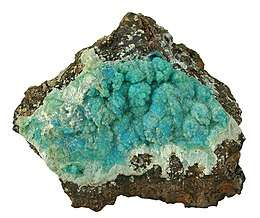Allophane
| Allophane | |
|---|---|
 | |
| General | |
| Category |
Phyllosilicates Kaolinite-serpentine group |
| Formula (repeating unit) | Al2O3·(SiO2)1.3-2·(2.5-3)H2O |
| Strunz classification | 9.ED.20 |
| Crystal system | Amorphous |
| Identification | |
| Color | White, pale blue to sky-blue, green, brown, yellow |
| Crystal habit | Crusts and masses |
| Cleavage | None |
| Fracture | Conchoidal |
| Tenacity | Brittle |
| Mohs scale hardness | 3 |
| Luster | Waxy to earthy |
| Streak | White |
| Diaphaneity | Transparent, translucent |
| Specific gravity | 2.8 |
Allophane is an amorphous to poorly crystalline hydrous aluminium silicate clay mineraloid. Its chemical formula is Al2O3·(SiO2)1.3-2·(2.5-3)H2O. Since it has short-range atomic order, it is a mineraloid, rather than a mineral, and can be identified by its distinctive infrared spectrum and its X-ray diffraction pattern. It was first described in 1816 in Gräfenthal, Thuringia, Germany. Allophane is a weathering or hydrothermal alteration product of volcanic glass and feldspars and sometimes has a composition similar to kaolinite but generally has a molar ratio of Al:Si = 2. It typically forms under mildly acidic to neutral pH (5-7). Its structure has been debated, but it is similar to clay minerals and is composed of curved alumina octahedral and silica tetrahedral layers.[1] Transmission electron micrographs show that it is generally made up of aggregates of hollow spherules ~3-5 nm in diameter. Allophane can alter to form halloysite under resilicating aqueous conditions and can alter to form gibbsite under desilicating conditions. A copper containing variety cupro-allophane has been reported.
It forms waxy botryoidal to crusty masses with color varying from white through green, blue, yellow, to brown. It has a Mohs hardness of 3 and a specific gravity of 1.0.
It was named from the Greek allos - "other" and phanos - "to appear", as it gave a deceptive reaction in the blowpipe flame in old mineralogical testing.
References
- ↑ Smalley,I.J. 1979. A spherical structure for allophane. Nature 281, 339 only
- Webmineral data
- Mindat
- Handbook of Mineralogy
- Wada, K. (1989), Allophane and Imogolite in Minerals in Soil Environments, Soil Science Society of America, no.1, pp. 1051–1087.
- Parfitt, R.L. (1990), Allophane in New Zealand. A Review. Australian Journal of Soil Research 28, pp. 343–360.